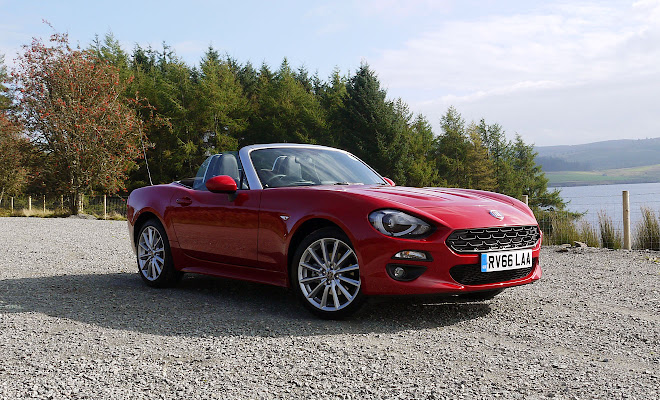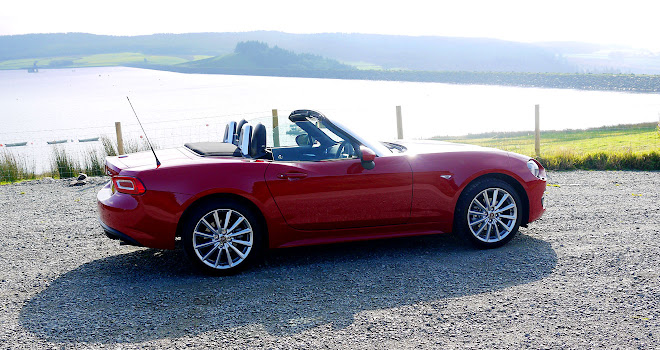
Rating: stars
Good: stylish, comfortable, great fun to drive
Bad: very little cabin storage, tiny boot
Price: from £19,545
OK, so sports cars are not really the most planet-friendly choice of transportation. A wide variety of sensible qualities such as fuel economy and practicality tend to be jettisoned by sports car designers in the pursuit of one hedonistic goal – a bit of fun behind the wheel.
But if you are going to buy a two-seater soft-top, this one really is a lot of fun. And there are lots more selfish options than the new Fiat 124 Spider. This car is light, modestly sized, responsibly quiet and squeezes oodles of enjoyment from relatively modest amounts of power.
You’ll also have to try pretty hard to see fuel economy worse than 35mpg. That’s the outcome achieved not by me but by a fellow journalist from a mainstream magazine, intent on clipping every apex along some of North Wales’ finest driving roads. Drive with the sun on your face rather than red mist in your eyes and you can bank on quite a few more miles per gallon. The official combined cycle result is 44.1mpg with a CO2 score of 148g/km.
That result might have been better still if the Spider had been made a little less enjoyable to drive. Stop-start, for example, is not fitted because it requires a bigger battery and beefier starter motor, both of which would pile unwelcome weight onto the front wheels. In turn, the additional heft would detract from the Spider’s ability to swing quite so crisply into corners.
Given that the sun visors have apparently been made by Tupperware in the search to save a few grammes, it would seem uncharitable to complain about the need to idle when motionless.

The 1.4-litre engine is, happily, one of Fiat’s clever MultiAir units. It uses variable valve timing to improve both economy and power output. There’s also a turbo, helping to boost the headline figures up to 140bhp and 240Nm, yielding a 0-62mph time of 7.5 seconds. The impressively light weight that I alluded to – just 1,050kg – helps to make the 124 Spider feel brisk and light on its toes.
There’s no mistaking that this Fiat relies on a turbocharger for get up and go, however. Below 2,000rpm in any gear other than first, the car will virtually ignore what you do with the throttle. Above 2,000rpm, by contrast, it will respond with puppy-like eagerness.
Picking the right gear is therefore essential for swift and seamless progress. Fortunately the manual change is short, sharp and squeaky clean, while the clutch has a firm, progressive bite. The lower quadrant of the speedometer will helpfully tell you which gear you’re in and will hint at both up and down shifts – with the aim of improving economy but not always with a great deal of sympathy for the fact that there’s no power at all at the bottom of the rev range.

The steering is wholly delightful – providing both fulsome feel and dainty precision without the tiresome weight that usually signifies a sporting setup.
Some of the new Fiat’s welcome qualities are down to Mazda rather than Fiat. Under its shapely skin the 124 Spider shares a lot with the latest MX-5. Fiat says it supplied its own styling and craftsmanship, the powertrain including gearbox innards, steering and suspension settings, and refinement in the shape of additional sound proofing compared with the Mazda.
While Mazda shared its underlying platform it apparently shared little else with the Italians. According to Fiat the Japanese refused to divulge their choice of suspension settings, for example. Similarly the 124 Spider’s designers got to see the MX-5’s bodywork for the first time in September 2014, along with the general public.
Happily there was some more reasonable give and take. Fiat says the MX-5 platform was originally destined for wheels no bigger than 16 inches. The Italians asked for 17s – and got them. And as a result buyers can now opt for the bigger wheels even when they buy a Mazda.
The large wheels probably do the fuel consumption no favours but they do help to make the 124 Spider look very well planted.

The exterior styling was inspired by the 1966 Fiat 124 Spider, or perhaps more specifically by the later twin-cam models with their double bonnet bulges. Other cues from the older car include the grille and headlamp shapes, the kicked-up crease above the door handles, and the inward sloping rear wings standing proud either side of the boot-lid.
The modern car is much bigger and its proportions are quite different too, dictated by the Mazda undercarriage. A much longer bonnet pushes the seating position back towards the rear axle, compared to the more midship cabin of the 1960s Spider.
Despite all its retro baggage, the modern 124 Spider is pretty appealing to the eye, even from behind the wheel – where you can see the bumps and curves of the bonnet and wings, helping to gauge the length of the car. In pictures I had winced at the vertical cutline running up and over the wings half a foot behind each headlamp, but it’s a relief to find that in the metal (and plastic) your eye doesn’t linger on this awkward join. As the designers intended, you tend to take in the front of the car as a seamless whole.

I found the cabin comfortable, cosy and well-screwed together, with the reassuring promise of Mazda reliability in many of the complicated bits you can’t see. There’s a seven-inch central screen with touch functions plus twist-and-prod controller that works surprisingly well, a pleasingly retro instrument cluster, a glovebox relocated to the bulkhead behind the seats, some very silly cupholders and an unpowered hood that you can open and close with one hand.
Roof down but windows up, there’s surprisingly little wind buffeting – assisted by a windbreak between the two roll hoops. You get to hear an encouraging amount of exhaust rasp as you barrel along. Roof up, the Fiat becomes surprisingly refined. The exhaust note is tamed but you can now clearly hear the whine of the turbo as the engine spools up for action.
The rear section of the hood feels like relatively thin layers of fabric, but the front section – which folds down neatly to look like a tonneau cover – is fairly rigid and I’m sure this design helps to keep wind noise at bay. A large glass rear screen is welcome, the big blind spots over each shoulder I’m not so keen on, but they can’t be helped in this kind of open-topped roadster.
Raiding the archives worked well for Fiat with the modern 500, and there’s no reason to suppose it won’t be equally successful with the 124 Spider. True, it may not be the most sustainable form of transport yet invented, but it is a pure joy to drive.




